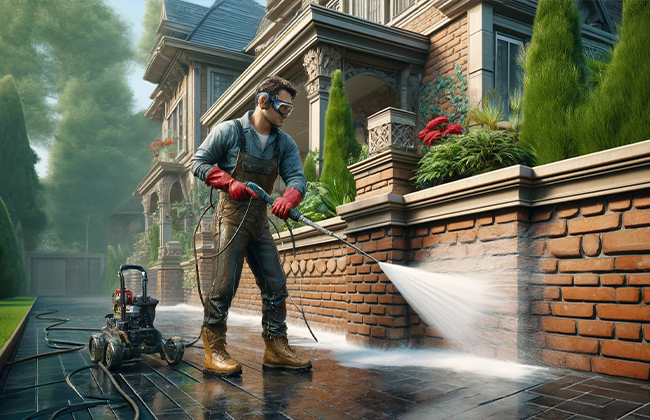Power washing brickwork is an effective way to clean and maintain the exterior surfaces of your home. By using a high-pressure water spray, you can remove dirt, grime, and other build-ups from brick surfaces, restoring their appearance and prolonging their lifespan. This guide dives into the techniques and tips for power washing brickwork efficiently.
Table of Contents
What is Power Washing?
Power washing, or pressure washing, is a cleaning method that employs high-pressure water spray to remove dirt, grime, moss, and other contaminants from various surfaces. When it comes to brickwork, this technique proves exceptionally effective. It penetrates the porous texture of bricks and mortar, drawing out stubborn stains without necessitating harsh chemical cleaners. By doing so, it not only cleans but also preserves the structural integrity and aesthetic value of the brick surfaces.
Preparing for Power Washing Brickwork
1. Safety First
Before you even start the power washer, it’s essential to suit up correctly. Safety cannot be overlooked. Make sure you’re wearing protective goggles to shield your eyes from any debris that might kick up during washing. Gloves are a must to protect your hands not just from dirt but also from any accidental scrapes against the brickwork. And let’s not forget about footwear—non-slip shoes are crucial to ensure you maintain a good grip, as surfaces can become slippery when wet.
2. Equipment Check
Now, about your equipment: not all power washers are suited for all jobs. For brickwork, it’s particularly important to use a power washer with adjustable pressure settings. Why? Because bricks can be damaged by too high a pressure. A 25-degree nozzle usually hits the sweet spot, providing enough force to clean effectively without damaging the mortar.
Step-by-Step Guide to Power Washing Brickwork
1. Inspect the Area: Take a good look at the area you’re about to clean. Any cracks or loose bricks? If yes, you’ll want to fix those first. Power washing can force water behind the wall through these gaps, which could lead to bigger problems down the line.
2. Pre-Wash Setup: Before you unleash the power washer, dampen the brick slightly. This might seem counterintuitive, but it actually helps by ensuring the high-pressure water doesn’t pull the mortar from between the bricks—a key step to prevent damage.
3. Cleaning Technique: Here’s how to get the best results: position the nozzle about 12-16 inches from the brick surface. Begin at the top and spray in a controlled, sweeping motion as you work your way down. This method helps prevent streaks and ensures an even clean across the entire surface.
4. Post-Wash Care: Once you’ve finished washing, give the area a thorough rinse with plain water to remove any remaining debris. This step is crucial to prevent any loose particles from drying onto the bricks and leaving stains. Let the brickwork dry completely, which might take a while depending on the weather conditions.
Best Cleaners for Brickwork
When it comes to cleaning your brickwork, choosing the right cleaner can make a big difference in both effectiveness and environmental impact. Let’s break down the options into natural and chemical categories, so you can pick what’s best for your needs.
Natural Cleaners
- Vinegar Solution: A simple yet effective cleaner, vinegar is great for removing mild stains and does not harm the environment. Mix equal parts water and vinegar, apply it to the brick with a spray bottle or brush, let it sit for a few minutes, then rinse it off. This solution is particularly good for removing efflorescence, those white salt deposits that sometimes appear on bricks.
- Baking Soda Paste: For tougher stains, baking soda can be your friend. Mix baking soda with water to create a thick paste, apply it to the stain, let it sit for 10-15 minutes, and then scrub gently with a brush. Rinse thoroughly with water. It’s a safe, mild abrasive that won’t damage the bricks.
Chemical Cleaners
- Muriatic Acid: This is a strong chemical cleaner that should be used with caution. Muriatic acid can effectively remove severe stains, efflorescence, and mortar splashes but must be handled safely. Always wear gloves, goggles, and protective clothing, and dilute the acid according to the manufacturer’s instructions. It’s crucial to thoroughly rinse the area with water after cleaning to neutralize the acid.
- Alkaline Cleaners: These are especially good at breaking down organic stains like mold or moss. Alkaline cleaners need to be applied, left to sit according to the product’s guidelines, and then scrubbed and rinsed off. They’re less harsh than muriatic acid but still require handling with basic safety gear.
Environmental Considerations
While natural cleaners are generally safer for the environment, chemical cleaners often provide the strength needed for tougher stains. However, it’s important to use them responsibly. Always follow the instructions for use and disposal provided by the manufacturer to minimize environmental impact. For instance, never pour leftover muriatic acid into storm drains or gardens as it can harm wildlife and plants.
Choosing the right cleaner for your brickwork involves balancing cleaning power, safety, and environmental impact. Whether you opt for natural solutions for lighter cleaning tasks or stronger chemical agents for stubborn stains, ensure you use them correctly and responsibly.
Troubleshooting Common Issues

When power washing brickwork, a few common issues may crop up, such as streaks, discoloration, and efflorescence. Let’s tackle these issues one by one and explore effective solutions to keep your brickwork looking its best.
1. Streaks
Streaks often occur when the washing technique is inconsistent or when the brick dries unevenly. To prevent streaks, always spray in a uniform pattern and maintain a consistent distance between the nozzle and the brickwork. Start at the top and work your way down to ensure that the water flows over the areas you’ve already cleaned, minimizing streak formation. If streaks do appear, a quick touch-up with a lower pressure setting can help even them out.
2. Discoloration
Discoloration can result from using the wrong cleaners or from old, weathered bricks that react unpredictably to cleaning. To avoid this, always test your chosen cleaner on a small, inconspicuous area of the brickwork before starting the full job. If discoloration occurs, switching to a gentler cleaning solution or diluting your cleaner can help mitigate the issue. For natural color revival, sometimes just a thorough rinse with plain water after cleaning is enough to restore the brick’s original hue.
3. Efflorescence
Efflorescence, the white powdery residue that sometimes appears on brick, is caused by soluble salts coming to the surface as the brick dries. Although it might seem stubborn, it’s often easily handled. First, try brushing it off with a dry, stiff brush. If that doesn’t work, washing the affected area with a vinegar solution (equal parts water and vinegar) can help dissolve the salts. Always rinse the area with clean water afterward to remove any lingering vinegar, which could further react with the bricks.
Pro Tips
- Always rinse your brickwork thoroughly after cleaning to remove any potential residue from cleaners, which could contribute to new stains or discoloration.
- Maintain a consistent washing schedule and technique to reduce the likelihood of having to troubleshoot in the first place.
By understanding these common issues and knowing how to address them effectively, you can keep your brickwork in pristine condition and avoid potential pitfalls that come with power washing.
Maintenance Tips for Brickwork
Maintaining your brickwork not only enhances the appearance of your home but also prevents long-term damage, ensuring the durability and structural integrity of the brick surfaces. Here are some essential tips to help keep your brickwork in top condition.
1. Regular Cleaning
Consistently cleaning your brickwork helps prevent the buildup of dirt and grime that can lead to more serious issues like staining or biological growth. Plan to wash your brickwork lightly every year with just water and perform a more thorough cleaning with appropriate cleaners every 2-3 years.
2. Check for Early Signs of Damage
Regularly inspect your brickwork for any signs of damage, including cracks, loose bricks, or mortar deterioration. Early detection allows for timely repairs, preventing minor issues from becoming major problems. Look especially around areas exposed to a lot of water or moisture, as these are more prone to damage.
3. Sealing the Bricks
Applying a sealant to your brickwork can provide a protective layer that repels water and minimizes wear from the elements. It’s important to choose the right type of sealant suitable for brick surfaces; breathable sealants are recommended because they allow moisture to escape, preventing damage from trapped water.
4. Repointing
Repointing is the process of renewing the pointing, which is the external part of mortar joints, in masonry construction. Over time, weathering and decay cause voids in the joints between bricks, allowing the undesirable entrance of water. Repointing these areas correctly can extend the life of your masonry.
Detailed Maintenance Schedule Table
| Maintenance Task | Frequency | Details |
| Light Cleaning | Annually | Use plain water with a soft brush to remove loose dirt and debris. |
| Thorough Cleaning | Every 2-3 Years | Use appropriate cleaners to remove tougher stains and biological growth. |
| Inspection | Biannually | Check for any physical damage or deterioration in mortar and bricks. |
| Sealing | Every 4-5 Years | Apply a breathable sealant to protect against water and weathering. |
| Repointing | As Needed | Address any deteriorated mortar joints to prevent water ingress. |
These maintenance tips, when performed regularly, will help ensure that your brickwork remains beautiful and structurally sound for years to come. Always remember to handle any chemicals or repairs with care and consider consulting a professional for major maintenance tasks like repointing and sealing.
Conclusion
Power washing brickwork is a superb method for keeping your home’s exterior clean and well-maintained. If you’re considering this for your property and seeking professional assistance, don’t hesitate to contact a seasoned contractor. For professional power washing brickwork services, you can reach out at (+1) 917-355-8556 to ensure your brickwork is handled with care and expertise.
FAQs
Q: What is the best time to perform power washing brickwork?
A: The ideal time to perform power washing brickwork is on a cloudy day to prevent the sun from drying the cleaning solutions too quickly, which can leave residues and uneven cleaning.
Q: How often should I schedule power washing brickwork?
A: It is recommended to schedule power washing brickwork every two to three years to prevent buildup and maintain the integrity and aesthetic of your brickwork.
Q: Can power washing brickwork damage my walls?
A: If not done correctly, power washing brickwork can lead to damage such as dislodged mortar or pitted bricks. Always use the correct pressure settings and techniques specific for brickwork.
Q: What should I avoid when power washing brickwork?
A: Avoid using extremely high pressure or incorrect nozzles when power washing brickwork as these can be too harsh and damage the bricks and mortar.
Q: Do I need to use chemicals when power washing brickwork?
A: While it’s possible to use just water, for tougher stains, specific chemicals can enhance the cleaning power. Ensure any chemicals used are suitable for brickwork and rinse thoroughly afterwards.




